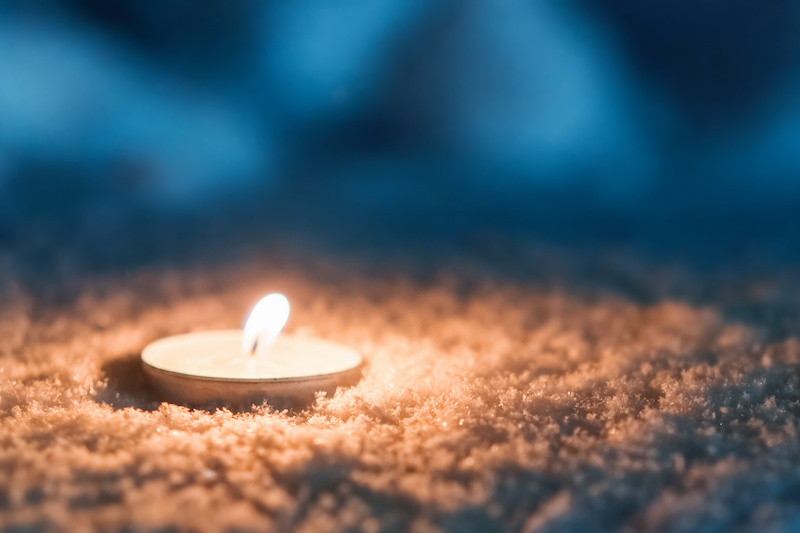In the Northern Hemisphere, the winter solstice occurs on December 21st and marks the shortest day and longest night of the year. Chinese Medicine holds that the winter solstice is not the beginning of winter, but rather the peak of the winter season and the most yin day of the year. Taoist theory sees all life and nature as a mix of yin and yang- the dark and the light, the reflective and the expansive, the cold and the warm, and the feminine and the masculine. There can never be one without the other; life is never an absolute, and instead always occurs on a spectrum. On the winter solstice, we are asked to, much like our ancestors who have been celebrating the winter solstice for over 12,000 years, turn inward and consider the darkness and shadows within ourselves, while acknowledging the hope and light that burns in our hearts. No matter how dark the day or the moment in our lives, the light always exists, and that is worth celebrating.
In fact, this theme of the light within the darkness is present within major religions and the celebrations that occur near the winter solstice. In Judaism, lighting the menorah honors the miracle of the lamp oil that burned for eight days instead of one. In Christianity, the birth of Jesus is considered to be the light within the darkness, and the star of Bethlehem served as a guiding light within the dark skies for the three wise men. During Kwanzaa, candles are lit to not only symbolize certain meanings of each day, but to also to symbolize hope, abundance of possibilities, and the power of the sun.
It is human nature to look for the glimmer of hope and possibility when things seem bleak; it is what keeps us going. We trust that like the days that follow the winter solstice, that light will grow, and our fortune will improve. We know that should we live long enough to see it, the yang energy of the summer sun will in a few short months warm our skin. Fruits and vegetables will be plentiful, and friendships and gatherings will be frequent. When we honor the winter solstice, we acknowledge the juxtaposition of the winter and summer, of yin and yang, and of dark and light. While we naturally value the abundance of the summer, there is also great value in accepting that darkness is an unavoidable, crucial, and necessary part of each of us and within the world. There cannot be light without the dark. We cannot know joy without also knowing sadness or loss.
Each of us carries our own version of darkness- that inner voice that says terrible things about you, depression, feelings of worthlessness or unworthiness, the trauma that broke you, or the rejection that caused you to feel unlovable. If you feel consumed by darkness, make sure you speak to a professional mental health therapist who can help you. For those who feel they can safely confront and explore their own darkness, the winter solstice is the perfect day to do so. Try this simple ritual:
- You will need: a candle, a piece of paper (or a couple), a pen or other writing utensil, a match or lighter, and a fire safe bowl/container/ashtray (optional)
- This ritual may be done outside or inside; depending on your home and surroundings, you may need to avoid the “Optional” part of the ritual listed below.
- In a dark room or outside when it is dark, light a candle. This serves as a reminder of the light within the darkness. Spend some time looking at the lit candle, mentally expressing gratitude for the light and warmth it provides. Notice how far the light spreads and how far away you can feel the heat of the fire. Consider any religious or spiritual symbolism you may identify with and the meaning of the light to you within that context.
- Take a few minutes to write down any of the “darkness” you may have in your life that you are ready to let go of, whether or not you feel strong enough. Thoughts, people, things, or ways you spend your time that no longer serve you- write them all down on the sheet of paper.
- Optional: If it is safe for you to do so, light the paper using the candle flame and place it onto the fire safe bowl/container/ashtray to fully burn (this part may be best done in an open area outside, away from any dry brush or grass that could catch fire); alternatively, you may also use a firepit, fireplace, or permitted bonfire if preferred. As it burns, envision the darkness being turned to light, and your “darkness” being released from your life. If you are unable to safely burn the paper, intentionally rip the paper into small pieces, while envisioning the “darkness” being released from your life.
This ritual can bring deep meaning to the winter solstice, and serves as a reminder that even in the darkest times, the light is always present, powerful and transformative.
Note: This article was originally published in a local magazine for their December 2022 issue. For citation references, please contact Dr. Yocum at https://jenyocum.com/contact/


Recent Comments